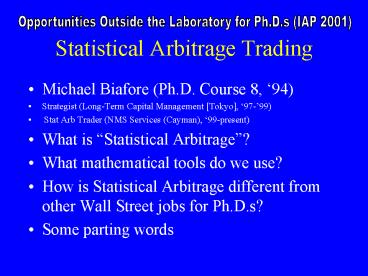Statistical Arbitrage Trading - PowerPoint PPT Presentation
1 / 9
Title:
Statistical Arbitrage Trading
Description:
Office politics. Managers. Compensation. Physical work environment. Parting words ... Money alone cannot begin to compensate you for work that does not excite you ' ... – PowerPoint PPT presentation
Number of Views:340
Avg rating:5.0/5.0
Title: Statistical Arbitrage Trading
1
Statistical Arbitrage Trading
Opportunities Outside the Laboratory for Ph.D.s
(IAP 2001)
- Michael Biafore (Ph.D. Course 8, 94)
- Strategist (Long-Term Capital Management Tokyo,
97-99) - Stat Arb Trader (NMS Services (Cayman),
99-present) - What is Statistical Arbitrage?
- What mathematical tools do we use?
- How is Statistical Arbitrage different from other
Wall Street jobs for Ph.D.s? - Some parting words
2
Statistical Arbitrage Trading
- What is arbitrage?
- In what sense is it statistical?
- What sorts of trading do we do?
- What are examples of things we do not do?
3
Tools That We Use
- Classical time series techniques (autoregression,
vector error correction, cointegration) - Statistical pattern recognition techniques
- Extreme value theory
- Statistical decision theory
- Game theory
4
(most of)
M.I.T.
Wall Street
trading
You are here
5
Statistical Arbitrage
research
trading
6
Risk Management
- Some interesting cross-disciplinary work, esp.
with statistical physics (e.g., see Theory of
Financial Risks From Statistical Physics to Risk
Management, BOUCHARD and POTTERS (2000),
Cambridge U. Press) - Several Wall Street firms are actively hiring
Ph.D.s in this area
7
Work environment
- Degree of autonomy
- Stress level
- Office politics
- Managers
- Compensation
- Physical work environment
8
Parting words
- On most of Wall Street, research is not the
central business function (yet) - Money alone cannot begin to compensate you for
work that does not excite you - Look before you leap (some suggestions)
9
References
- Time Series Analysis, J.D. Hamilton (1994)
- Statistical Pattern Recognition, A. Webb (1999)
- A Probabilistic Theory of Pattern Recognition,
L. Devroye et al., (1996) - Statistical Learning Theory, V.N. Vapnik (1998)
- Modelling Extremal Events, P. Embrechts et al.
(1998)































